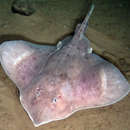Diagnostic Description
provided by Fishbase
Snout moderately long, its tip pointed and somewhat protruding; upper surface predominantly smooth, only on head and front margins more or less prickly, tail entirely spinulose, underside smooth; up to 4 thorns in front of as well as behind eye, a continuous median row of 42-51 thorns from nape to first dorsal fin (Ref. 3167). Upper surface plain fawn color, slate grey or clay grey, lower surface white, with a grey longitudinal band along tail and grey blotch on either side of cloaca (Ref. 6902).
- Recorder
- Arlene G. Sampang-Reyes
Life Cycle
provided by Fishbase
Oviparous (Ref. 3167). Paired eggs are laid. Embryos feed solely on yolk (Ref. 50449). Distinct pairing with embrace. Young may tend to follow large objects, such as their mother (Ref. 205).
- Recorder
- Cristina V. Garilao
Morphology
provided by Fishbase
Dorsal spines (total): 0; Analspines: 0; Analsoft rays: 0
- Recorder
- Arlene G. Sampang-Reyes
Trophic Strategy
provided by Fishbase
Occurs in moderately deep water but mainly around 250 m in boreal and partly arctic latitudes. Feeds on all kinds of bottom animals.
- Recorder
- Drina Sta. Iglesia
Biology
provided by Fishbase
Occur in moderately deep water but mainly around 250 m in boreal and partly arctic latitudes (Ref. 3167). Maximum reported depth at 2,117 m (Ref. 117245). Benthic (Ref. 58426). Feed on all kinds of bottom animals (Ref. 3167), invertebrates and fishes (Ref. 114953). Males mature at ca. 90 cm TL and young hatch at ca. 15 cm TL (Ref. 119696). Oviparous. Distinct pairing with embrace. Young may tend to follow large objects, such as their mother (Ref. 205). Eggs are oblong capsules with stiff pointed horns at the corners deposited in sandy or muddy flats (Ref. 205). Egg capsules are 10.7 cm long and 7.7 cm wide (Ref. 41251, 41301).
Rajella lintea: Brief Summary
provided by wikipedia EN
Rajella lintea is a species of fish belonging to the family Rajidae.
It is native to the coasts of Northern Atlantic Ocean.
Synonym:
Dipturus linteus (Fries, 1838)
- license
- cc-by-sa-3.0
- copyright
- Wikipedia authors and editors

